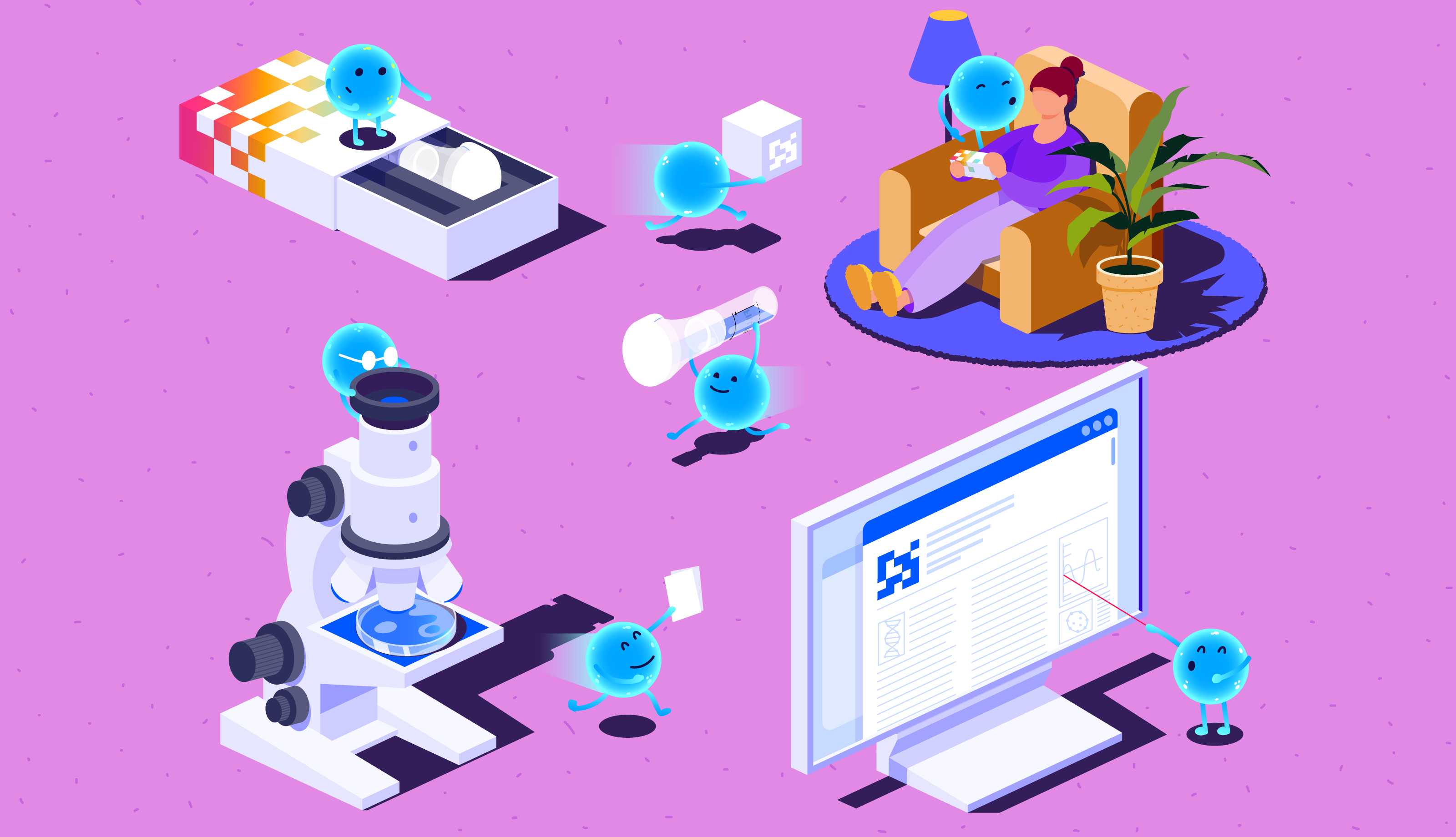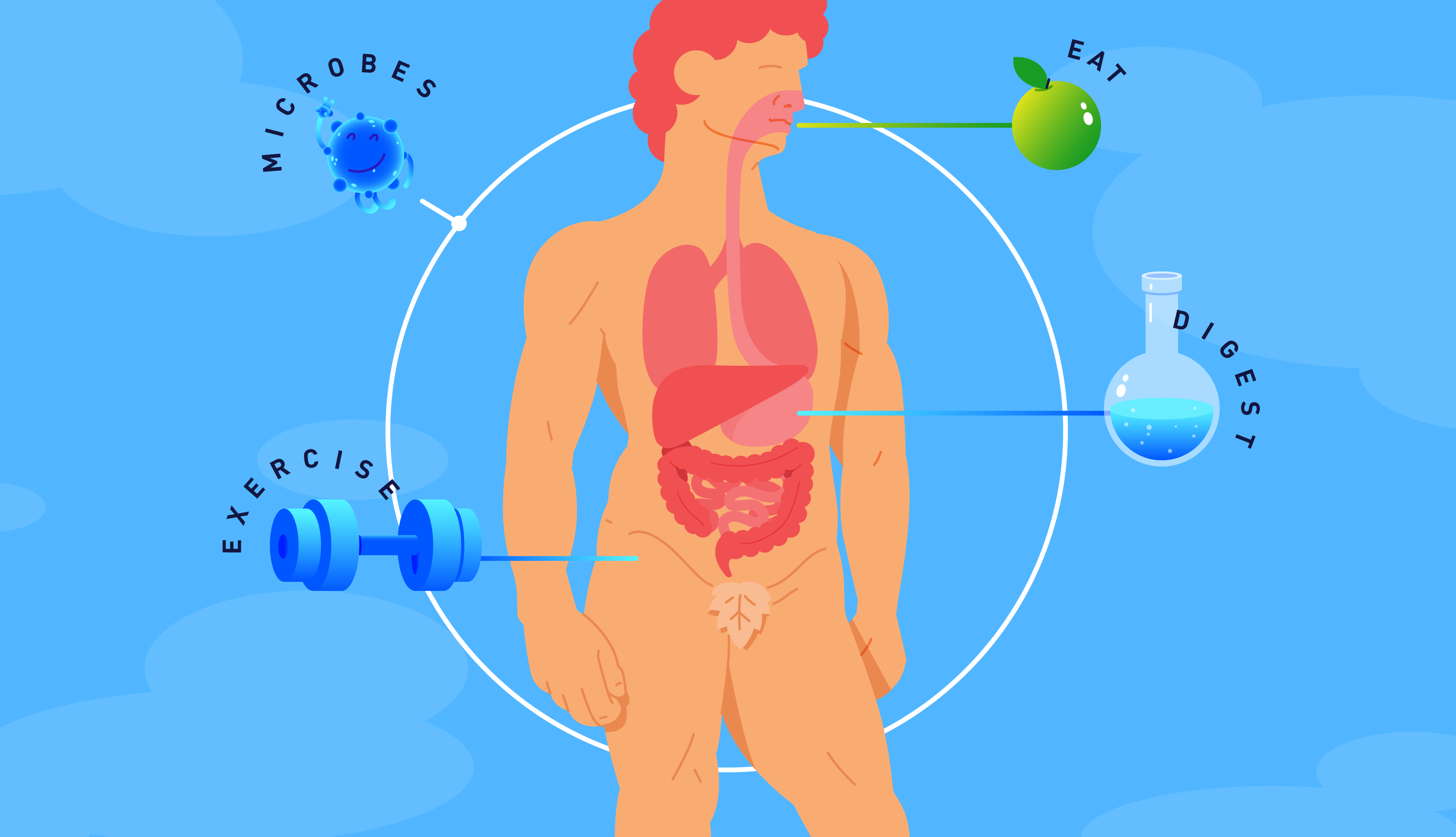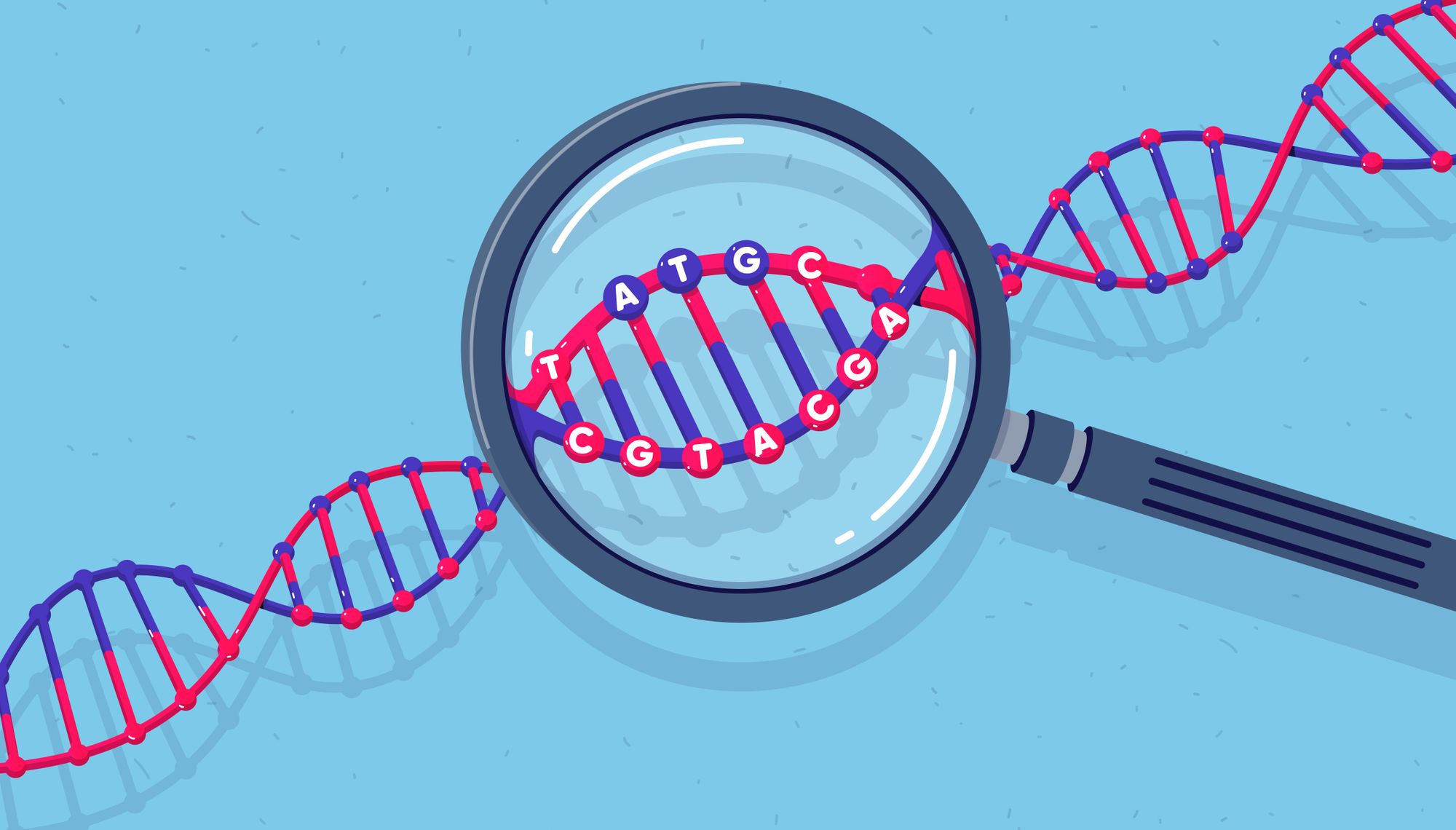Find out what to expect when you take an Atlas DNA Test from your kit delivery to accessing your results in the personal account.
Now that you can get your DNA tested from home, you probably have a few questions about how it works and what purpose it serves. Here, we explain what happens after you order the Atlas DNA test and why each step matters.
Table of contents
- What’s in the DNA test kit?
- 7 mistakes that spoil your sample
- What happens at the laboratory?
- How DNA genotyping works
- What results should you expect?
- Get a complete health check
It seems pretty straightforward: open the kit, spit in a tube, post the sample back, and get your results. But there’s a bit more to it, so come with us behind the scenes to see how we turn saliva into actionable information about you and your health.
What’s in the DNA kit?
Register the barcode from your DNA kit in your personal account, collect your sample carefully, and post it back to us.
When you buy an Atlas DNA Test, we send a courier with the kit to your doorstep. The distinctive white box has everything that you need to collect your saliva sample and post it back. Just don’t forget to read and follow the instructions!
| What’s in the box? | Instructions |
| Sample collection tube | |
| Prepaid postage label (on the box) |
☝TIP☝The box is already stamped and addressed. Just drop it in your nearest postbox, and it will be sent to our lab for testing.
Mistakes that spoil your sample
There are several easy ways to ruin your saliva sample that will make it impossible for the lab to read your DNA. So, please read the instructions.
Start by creating a personal account on our website to register the barcode on the side of your sample collection container. If you skip this step, we will not find your results.
Now you can prepare for the sample collection by reading the instructions, because there are several ways to spoil your sample that make it impossible for the lab to read it. As a general rule, don’t put anything in or near your mouth for 30 minutes before spitting in the tube.
Don't give your saliva sample after putting other stuff in your mouth
For example, if you kiss someone before collecting your saliva, you’re actually swapping a little bit of DNA with your partner and that can invalidate your sample. And this 30-minute rule also applies to food and drink.
A cup of tea or a biscuit will leave traces in your saliva because the molecules contaminate the sample. Chewing gum, brushing your teeth, and smoking can too, so please do leave a 30-minute window before collecting your saliva!
Finally, do not collect your sample right after you wake up. During the night, you produce less saliva and anaerobic bacteria have a party (#dragonbreath), and that affects the quality of your sample. Give your body some time to wake up before you spit in the tube.
| Remember to: | 1. Register the barcode on the tube |
| 2. Fill the sample tube up to the line | |
| Wait for 30 minutes after: | 1. Food or drink |
| 2. Chewing gum | |
| 3. Smoking | |
| 4. Kissing | |
| 5. Waking up |
With these rules in mind, you can now collect your sample like a pro. Spit in the tube to fill it up to the line, then place your sample back in the original box. It takes some effort and a few minutes to get that much saliva, so don’t get discouraged.
Samples are analysed in batches and audited by a geneticist to verify there are no misreads. That’s why it takes 4-6 weeks for your results to land in your personal account. In the meantime, we will send weekly emails to get you ready for your results and help you understand how DNA testing works.
Your privacy and data safety are our top concern. We store your information anonymously on certified encrypted European servers. You own your data, we don’t sell it, and you can have it deleted at any time.
☝IMPORTANT☝Your barcode is used to identify your sample. If you do not register it, we will not find your results!
What happens at the laboratory?
Your body relies on more than 20,000 tiny blueprints, called genes. Almost every cell in your body keeps a full library of your genes in DNA molecules.
The saliva sample that you have sent back to us has cells from your mouth. Don’t worry, they were old and are already replaced with younger tissue. Our experts use these cells to extract your DNA for analysis.
Almost every cell in your body has a full copy of your DNA (deoxyribonucleic acid). It looks like a twisted staircase (scientists call it a “double helix”), and it’s made up of four nucleotides: adenine (A), cytosine (C), guanine (G), and thymine (T).
Every living organism uses 4-letter DNA sequences to store information as genes, which are ‘hereditary’: you get them from your parents. About a half of your DNA comes from your mother, the rest is from your father.
Your genes store a lot of information that dictates how your body develops and reacts to the environment. Together, genes are like a library with blueprints and strict instructions for every cell in your body. And now, scientists have figured out what genes are important to your health, metabolism, and other important aspects of your wellbeing.
☝TIP☝Your DNA is completely unique, unless you have an identical twin. If that’s the case, then your DNA will be almost identical.
How DNA genotyping works
The Atlas DNA test is designed to study well-researched parts of your DNA that can tell us about your body and your health.
Your genome is made of about 3 billion (109) chemical letters, but we do not need all of this information. Instead the Atlas DNA Test looks at genetic variants that are reliably proven to be associated with important information about your health and ancestry.
Human DNA has conserved regions, which are the same for all people. The scientists use this structural similarity to identify and study specific genes. After that, the data is interpreted by the Atlas algorithm which looks for variations in the 4-letter code of your genes.
DNA genotyping and interpretation usually takes between four and six weeks. When your results are ready, you can access them in your personal account online or via the Atlas app. Here is what you’ll learn about your body.
What results should you expect?
*The Atlas DNA test results explain how your genes influence your disease risks, eating preferences, sports metabolism, personal traits, and ancestry. *
Our test analyses over 400 genetic traits. That’s a lot of information, so we grouped it into five categories to make it easier to understand. Of course, your results always come with a detailed explanation of every report.
| Information type | Number of reports |
|---|---|
| 1. Health | 343 reports |
| 2. Nutrition | 18 reports |
| 3. Sports | 7 reports |
| 4. Ancestry | 4 reports |
| 5. Personal traits | 13 reports |
| Lifestyle Insights |
Disease risks
The Atlas DNA test is designed to help you learn more about your health. Together with a general overview of your health status, the health tab reports the influence of your genes on disease risks and shows if you carry any hereditary conditions.
Underneath the slider, there are three percentages. The first one tells you disease prevalence, which is the average risk of developing a condition. It is followed by genetic impact that shows how your DNA variants increase or reduce this risk.
However, genetic predisposition to a disease is not a final sentence. The third number, lifestyle impact, tells if your current diet, exercise, and other habits help you to counter the disease risk. We calculate this using data from your health questionnaire.
This means that you can make positive lifestyle changes and reduce your disease risks. For instance, making the right food choices can significantly improve type II diabetes risks! Your results can tell you how to take action, and the rest is in your hands.
If both you and your partner carry genes for a hereditary condition, your future children may be at risk of this disease, which is why we recommend DNA testing before starting a family. We also offer genetic counselling services to help future parents understand the implications of their results.
Nutrition
The nutrition tab of your DNA test results is there to tell you how your body deals with food and drink. For example, you can see if your DNA predisposes you to specific intolerances: gluten, alcohol, or lactose.
In the vitamins, minerals, and fatty acids tab, you can check your predisposition to high or low levels of these important nutrients. If your genes affect production or transport of certain elements, you should consult your doctor before taking supplements or making changes to your diet.
You can also find out about your caffeine metabolism. Its speed depends on your version of a liver protein gene called CYP1A2, and after the DNA test, you will know how many cups of coffee your body can tolerate without getting the shakes.
There is also a section dedicated to eating behaviours where you can learn if you are sensitive to the taste of coriander or bitterness. These features can influence your food preferences, and knowing about them can help you to maintain a healthy diverse diet.
Ancestry
Your genes come from your parents. However, the split is not equal. For instance, the DNA in mitochondria - tiny power plants inside your cells - always comes from your mother, but the Y chromosome is only inherited from your father.
Find out really how much Neanderthal is in your genes
Everyone has mitochondrial DNA, but only boys carry the Y-chromosome. Scientists have figured out that mitochondrial and Y-chromosome DNA accumulated small changes over the course of human history.
By looking for these variants, the DNA test can follow your ancestral roots by ancient tribes called haplogroups. You can also see the population composition, geography of your ancestry by regions of the globe, and discover what the percentage of Neanderthal genes are in your DNA.
Sports and Personal traits
Your personal account has a sports tab that describes how your metabolism influences your performance in sports and predisposition to sports injuries. For example, you can learn about your levels of erythropoietin .
Erythropoietin (EPO) is a hormone that regulates the formation of Red Blood Cells.These cells carry oxygen from your lungs to organs and muscles, so increased EPO levels give athletes an advantage!
Your genes also dictate a bunch of curious personal traits.The DNA influences how our brain and nerves process different stimuli, so the test can tell if you are sensitive to things like the smell of violets or malt.
Your sensitivity to pain, chances of early gray hair, and even whether you sneeze in sudden sunlight - these and other little things that can help you better understand your body are waiting in the ‘Personal traits’ tab.
Lifestyle insights
Your DNA test tells a lot of things at once. It can be hard to keep all recommendations in mind. To help you make the most out of it, we have created a sixth tab with clear and easy-to-implement lifestyle advice based on your DNA.
The lifestyle insights indicate if you need to have a chat with your GP to ask specific questions, check your vitamin levels, or avoid drinking too much coffee. From there on, it is all in your hands!
Get a complete health check
Your DNA doesn’t change, but your life does. So do your gut bacteria. Our tests adapt to changes in your environment so you can track and monitor your wellbeing over time.
We don’t just analyse people’s DNA, we want to help guide you towards the longest, healthiest, and happiest life you can. Once you’ve done a DNA Test, you don’t need to do it again.
When we add new traits to the personal account, your results are updated for free. You can also combine these results with a microbiome test to check how your gut bacteria influence your health and nutrition. This will update your results with new insights.
When you start applying your recommendations from the Atlas DNA Test, or if something in your life changes like your diet, weight, family history, or exercise regime, you can take the health questionnaire and it will update your insights based on this new information!
For a full health check, our experts recommend combining the Atlas DNA and Microbiome Tests allows you to assess the effect of your new habits and make positive choices for your overall well-being.
☝️TIP☝️Uncover your health with the Atlas DNA Test and get 10% off when you sign up for blog updates!





















